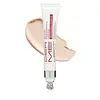What's inside
What's inside
 Key Ingredients
Key Ingredients

 Benefits
Benefits

 Concerns
Concerns

 Ingredients Side-by-side
Ingredients Side-by-side

Water
Skin ConditioningC12-15 Alkyl Benzoate
AntimicrobialHydrogenated Polyisobutene
EmollientGlycerin
HumectantAcrylates Copolymer
Pvp
Emulsion StabilisingSilica
AbrasiveCetyl Alcohol
EmollientGlyceryl Stearate
EmollientPEG-100 Stearate
PEG-40 Stearate
EmulsifyingDimethicone
EmollientHydrolyzed Sesame Protein Pg-Propyl Methylsilanediol
Skin ConditioningHydrolyzed Wheat Protein
Skin ConditioningSoy Protein Phthalate
EmollientPolyacrylamide
C13-14 Isoparaffin
EmollientLaureth-7
EmulsifyingSteareth-20
CleansingN-Hydroxysuccinimide
Skin ConditioningChrysin
Skin ConditioningPalmitoyl Tripeptide-1
Skin ConditioningPalmitoyl Tetrapeptide-7
Skin ConditioningButylene Glycol
HumectantAcetyl Tetrapeptide-5
HumectantPhenoxyethanol
PreservativeEthylhexylglycerin
Skin ConditioningCI 77891
Cosmetic ColorantCI 77491
Cosmetic ColorantWater, C12-15 Alkyl Benzoate, Hydrogenated Polyisobutene, Glycerin, Acrylates Copolymer, Pvp, Silica, Cetyl Alcohol, Glyceryl Stearate, PEG-100 Stearate, PEG-40 Stearate, Dimethicone, Hydrolyzed Sesame Protein Pg-Propyl Methylsilanediol, Hydrolyzed Wheat Protein, Soy Protein Phthalate, Polyacrylamide, C13-14 Isoparaffin, Laureth-7, Steareth-20, N-Hydroxysuccinimide, Chrysin, Palmitoyl Tripeptide-1, Palmitoyl Tetrapeptide-7, Butylene Glycol, Acetyl Tetrapeptide-5, Phenoxyethanol, Ethylhexylglycerin, CI 77891, CI 77491
Water
Skin ConditioningButylene Glycol
HumectantAscorbic Acid
AntioxidantGlycolic Acid
BufferingSalicylic Acid
MaskingAloe Barbadensis Leaf Extract
EmollientArginine
MaskingVitis Vinifera Seed Extract
AntimicrobialEchinacea Purpurea Extract
MoisturisingHamamelis Virginiana Extract
AntiseborrhoeicGlycerin
HumectantSodium Hyaluronate
HumectantAllantoin
Skin ConditioningHydroxyethylcellulose
Emulsion StabilisingAlcohol Denat.
AntimicrobialPhenoxyethanol
PreservativeEthylhexylglycerin
Skin ConditioningSodium Hydroxide
BufferingWater, Butylene Glycol, Ascorbic Acid, Glycolic Acid, Salicylic Acid, Aloe Barbadensis Leaf Extract, Arginine, Vitis Vinifera Seed Extract, Echinacea Purpurea Extract, Hamamelis Virginiana Extract, Glycerin, Sodium Hyaluronate, Allantoin, Hydroxyethylcellulose, Alcohol Denat., Phenoxyethanol, Ethylhexylglycerin, Sodium Hydroxide
Ingredients Explained
These ingredients are found in both products.
Ingredients higher up in an ingredient list are typically present in a larger amount.
Butylene Glycol (or BG) is used within cosmetic products for a few different reasons:
Overall, Butylene Glycol is a safe and well-rounded ingredient that works well with other ingredients.
Though this ingredient works well with most skin types, some people with sensitive skin may experience a reaction such as allergic rashes, closed comedones, or itchiness.
Learn more about Butylene GlycolEthylhexylglycerin (we can't pronounce this either) is commonly used as a preservative and skin softener. It is derived from glyceryl.
You might see Ethylhexylglycerin often paired with other preservatives such as phenoxyethanol. Ethylhexylglycerin has been found to increase the effectiveness of these other preservatives.
Glycerin is already naturally found in your skin. It helps moisturize and protect your skin.
A study from 2016 found glycerin to be more effective as a humectant than AHAs and hyaluronic acid.
As a humectant, it helps the skin stay hydrated by pulling moisture to your skin. The low molecular weight of glycerin allows it to pull moisture into the deeper layers of your skin.
Hydrated skin improves your skin barrier; Your skin barrier helps protect against irritants and bacteria.
Glycerin has also been found to have antimicrobial and antiviral properties. Due to these properties, glycerin is often used in wound and burn treatments.
In cosmetics, glycerin is usually derived from plants such as soybean or palm. However, it can also be sourced from animals, such as tallow or animal fat.
This ingredient is organic, colorless, odorless, and non-toxic.
Glycerin is the name for this ingredient in American English. British English uses Glycerol/Glycerine.
Learn more about GlycerinPhenoxyethanol is a preservative that has germicide, antimicrobial, and aromatic properties. Studies show that phenoxyethanol can prevent microbial growth. By itself, it has a scent that is similar to that of a rose.
It's often used in formulations along with Caprylyl Glycol to preserve the shelf life of products.
Water. It's the most common cosmetic ingredient of all. You'll usually see it at the top of ingredient lists, meaning that it makes up the largest part of the product.
So why is it so popular? Water most often acts as a solvent - this means that it helps dissolve other ingredients into the formulation.
You'll also recognize water as that liquid we all need to stay alive. If you see this, drink a glass of water. Stay hydrated!
Learn more about Water